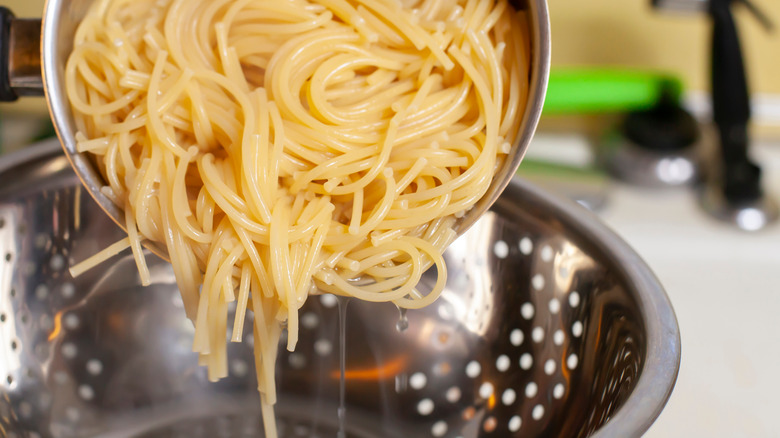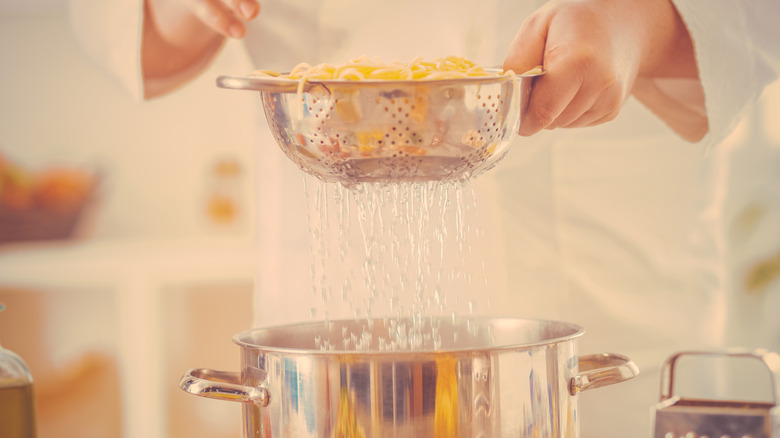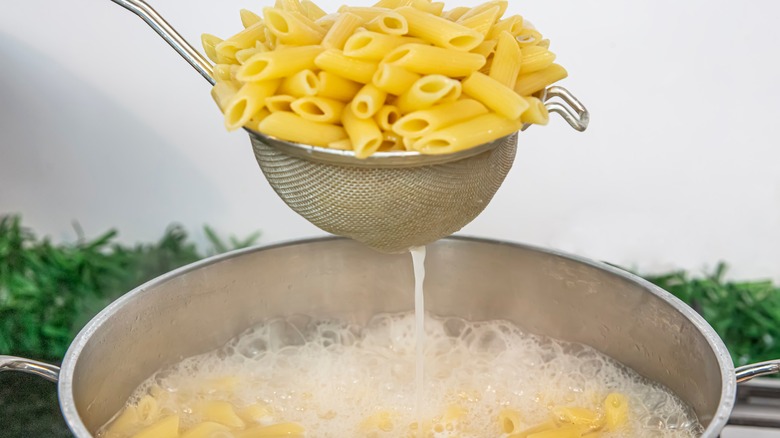There's A Better Way To Pour Pasta Water Down The Drain
Cooking pasta is like creating art in food form, requiring only boiling water and a heavy pinch of salt to achieve an edible masterpiece. Of course, before you can savor your perfectly al dente pasta, the salty water must be removed. While straining it over the sink is certainly the quickest way to get rid of the leftover liquid, it's definitely not the best. A far better disposal method involves straining your boiling water into a separate container to let it cool down first.
Though it may seem like an innocuous act, dumping scalding water down the drain can actually cause major damage to your plumbing, particularly if you have plastic pipes. These are typically able to withstand temperatures only between 140 degrees and 200 degrees Fahrenheit. Since the boiling point of water is 212 degrees Fahrenheit, these high temperatures can soften or even melt the pipes, and crack sinks made of more delicate materials like porcelain.
So, whether you've just cooked rice, blanched vegetables, boiled potatoes, or whipped up a pot of spaghetti noodles, don't pour your hot water down the drain — let it cool down first instead.
The key is to strain the pasta water into a bowl first
Give your sink's pipes a little TLC by being mindful of how you dispose of boiling water. Instead of pouring it directly down the drain after removing it from the stove, first strain it into a separate container designed to withstand high temperatures, such as another pot or a large stainless steel mixing bowl.
For a pipe-safe water-draining method, simply place your colander over the container to strain your cooked pasta, veggies, or other food items. Exercise caution if using a bowl, as it could easily tip over. Then, allow the hot water to cool before dumping it down the sink. (For reference, it generally takes about 12 minutes for boiling water to dip below 140 degrees Fahrenheit, and about 45 minutes for it to cool to room temperature.)
As an even better alternative, there are several ways to utilize your leftover liquid that will put it to good use, such as incorporating it into other dishes.
Other genius ways to put pasta water to good use
Your unwanted pasta water is more valuable than you might think. When noodles are boiled, they release starch, which is what gives the water its cloudy, murky appearance. Often dubbed "liquid gold," this starchy fluid acts as an emulsifier — an agent that helps blend liquids together — and a thickener. By adding about one-fourth to one-half cup of it to your pasta sauce, you can make the sauce creamier, especially if it's on the oily side.
But that's not all: Leftover pasta water can be used to enhance homemade bread for better browning and a crispier crust. It can also serve as a base to add richness to soups and stews, and to season and soften dried beans. Once cooled, if it's not salted or seasoned, it can even be used to water your plants, making for an exceptionally low-waste and pipe-friendly solution for disposing of your cooking water. So next time, think twice before sending that liquid gold down the drain!



